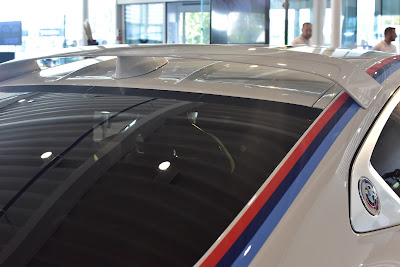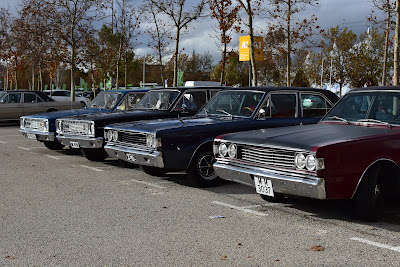I think it would be safe to call racecars the fighter jets of the road. NACA ducts, disc brakes, carbon fiber, etc. all originated from the aviation industry before being implemented into racecars, and only then finding their way into your average Ferrari or Citroen. In the 60's, Mazda (still called the Toyo Cork Kogyo Corporation) was relatively new to the scene of car production. Nonetheless, innovation was the company's favorite word and they'd been experimenting with their own version of a new alternative to the traditional internal combustion piston engine. The power plant was named the "Wankel" (pronounced "Vankel", you wank enthusiasts!) after its inventor, Felix Wankel. Although Felix is the man who introduced the initial concept to NSU, the german car and motorbike manufacturer he was working with at that time, it was the company's engineer, Hanns Dieter-Paschke, who came up with the fixed-housing design to replace the original rotating-housing design in 1957. So, Wankel got all the fame whereas Paschke's design became the basis for every single rotary developed to power cars, trucks, motorbikes, and even a chainsaw. I mean, history cred is overrated anyway!
The year was 1959, and the Wankel's hype was growing by the week. Everyone's driving around in appallingly slow, single-cam cars like the Citroen 2CV, the Beetle, etc., and here's this high-revving, smooth and versatile engine, with less than half of a conventional engine's components. It was considered the engine of the future, with one design even being able to run on multiple fuels, like hydrogen. Consequently, NSU wanted a return in their pricy and soon-to-be financially catastrophic investment and turned to licensing the Wankel engine. Significant players in the industry of the likes of Citroen, General Motors, Mercedes, and of course, Mazda (to name a few) bought licenses and dove headfirst into the future. Unfortunately, things didn't quite materialize as expected, and only Mazda and Citroen with the GS Birotor managed to build and sell rotary-powered production cars. Citroen tried to experiment with using a rotary powerplant for the legendary SM, though complications forced them to give up and use the 2.9 lt Maserati V6 instead.

For reasons that could only be described as pure love for a novel concept merged with Japanese determination, Mazda went to great lengths to transform NSU's Comotor Wankel engine into a financially viable idea. You see, NSU's second and last rotary automobile, the Ro80, also known as the german DS, was a revolutionary sedan with a low-drag coefficient, four-wheel disc brakes, a semi-automatic gearbox, and a 1.3lt twin-rotor engine making 110 hp, which ended up being the last nail in the coffin for the manufacturer's demise. Innovation is amazing as long as it works for more than five minutes, something untrue to Ro80's character. The first generation of this model, introduced in 1967, was so unreliable, owners would take out their hands and signal each how many engines they had replaced as they whizzed past each other. The main issue was a lack of knowledge of the Wankel's maintenance by the general public, like warming up the engine, regular oil checks etc, which were ignored by the average Joe's and Jane's. Neglectful owners, married with the flawed apex seal design (apex seals are the rotary equivalent of combustion chambers) were the perfect match for premature engine failure. To save what was left of their reputation, NSU scrambled to replace the cars under warranty. Unfortunately, the tactic didn't work, and after only three model years of the Ro80, the company went bust. In the end, it was bought by VW-Audi and continued to produce the slightly improved second-gen until 1977.

Mazda had a difficult deck of cards to play within their hands and they were ready to give it their best shot. In 1967, they released one of the most beautiful and unique sports cars ever conceived: the Cosmo 110S. Powered by the L10A, 1.2lt twin-rotor Wankel making 110 hp and about 130 N-m of torque, it was a serious bit of kit. The car's roofline comes up to average adult waist level and the design kinda resembles a four-wheeled arrow. If I were a rich man, I'd get one to drive around and one to gawk at in my living room. People were awestruck when they first laid their eyes on the elegant Cosmo at the 1964 Tokyo Motor Show, an especially surprising feat from a company known for mini-economy cars, tricycles, and... corks. Not long after the 110s' release to the public, Kenichi Yamamoto, the rotary's chief engineer, thought it'd be crucial to test the car and the powertrain through the most grueling race of the period: the 84 hours of the Nurburgring, once called the Liege-Rome-Liege. Naturally, the racecars had to be modified to face the challenging conditions. Numbers 18 and 19 received an updated version of the L10A rotary called the L10B, which increased the power to 130 hp at 7,000 rpm and torque remaining more or less the same as before. Also, the wheelbase was lengthened to increase stability. The intense stress testing at the Suzuka circuit would convince the engineers to implement the recent updates to all Cosmo road cars from now on, while also reassuring them of the car's ability to at least finish the race.

On the 20th of August 1968, the two race-ready, mostly stock Cosmos were parked and inspected at the original starting point of the Liege-Rome-Liege, in front of the "Palais des Princes Eveques" at Liege, Belgium. Surrounded by Mini Coopers, Lancias Fulvias, Porsche 911s, and numerous other makes and models, the Cosmos must've looked as exotic as a pair of panthers amongst housecats. They were brand new, ultra-rare, and powered by triangles instead of pistons. I can't even begin to imagine people's reactions when they first heard the unrestricted rotaries scream to their pretty stratospheric redlines for 60's standards. It was definitely a sundae delight for the eyes and ears of fans. Following the end of the inauguration ceremony, the racers and their crews departed for the starting line at the Nurburgring, a.k.a. "The Green Hell".
The racers took off as soon as they set foot (or tires in this case) on the circuit and they faced a challenging feat for both man and machine: to lap the 28.91 km track as many times as possible, in 84 hours and with only one hour of total rest over the entire race. Absolutely bonkers, to say the least! Drivers of the past were made from a different type of gasoline. Speaking of drivers, Mazda had recruited five, high-skilled blokes to pedal the Cosmos to the finish line and, hopefully, the podium. The red-striped number 18 was piloted by Nobuo Koga and Masami Katakura, whereas the yellow-striped number 19 was handled by the Belgian trio, composed of Jean-Pierre Ackermans, Leon Last, and Yves Deprez. Fun fact: Belgian drivers would accompany Mazda in a large portion of the rotary's most significant victories, all the way to the historical win at the '91 24 hours of Le Mans. Sashimi and waffles, unite!
Both Cosmos were holding up quite well over the majority of the race. Though they couldn't catch up with the leading Porsche 911 Es, Lancia Fulvias, and MG MGCs, they steadily climbed the ranks while exploring uncharted territory. When hour 80 came about, a weakened axle broke on the red-striped Cosmo and one of the rear wheels went on vacation. Number 18 was out. Thankfully, Katakura, who was the driver during the incident, walked away unscathed. The Sashimis were done and the Cosmo's reputation rested in the Waffles' hands. The yellow-striped wonder from the East held up behind the 911 Es in first and second and the Fulvia in third place, managing a fourth-place finish at hour 84. The Waffles' 110S had lapped the Nurburgring Sud and Nordschleife 344 times, covering almost 10,000 km in the process. What an accomplishment, especially taking into account the challenging race conditions and the drivetrain's novelty.

In the end, Mazda was satisfied with the race's results. Even though they narrowly missed a podium finish, the engineers were now determined to turn rotary-powered cars into a force to be reckoned with. As for the 110S, with an average of one car built every day from 1967 to 1972, only 1,176 were ever produced. Along with the Toyota 2000GT and Datsun Skyline GTR "Hakosuka", the Cosmo is among the most desirable and rare Japanese sports car legends. Pictures don't do it justice. I had to witness it in the flesh to truly savor its aura. If, say, both Cosmos had blown up at the Marathon de la Route and a couple of future races, Mazda would've abandoned the rotary like the demanding, misunderstood yet the innovative child that it was. On the contrary, the company nurtured and meticulously developed the Wankel, putting it inside sportscars, GT cars, estates, and even a pick-up truck. It has won almost all major races on national and international championships, especially when it was powering the first generation of the RX-7. Nevertheless, as of 2021, the engine has been dormant for nine years since the RX-8's discontinuation, and due to this vague attempt by the world's governments to reduce emissions and save the oil companies' (a.k.a. the ACTUAL government's) paychecks, we'll most probably never see another rotary-powered Mazda (what else?) again. It's being said the company might revive the Wankel as a pathetic range-extender for electric cars, but its future still remains questionable. All we can be sure about is this: it's called the Wankel, it goes Brap-Brap-Brap and it won't stop 'till everyone's eardrums get pierced with the song of spinning Doritos!













































